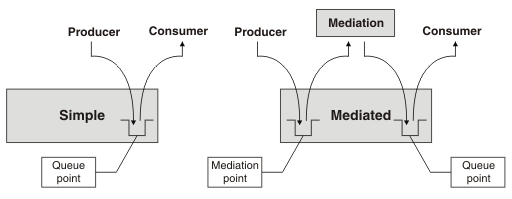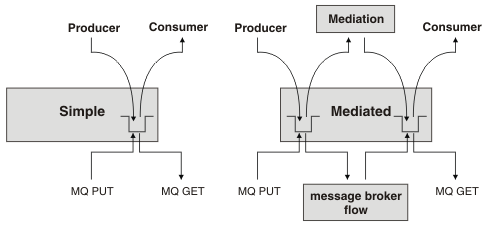Network Deployment (Distributed operating systems), v8.0 > Applications > Messaging resources > Interoperation with WebSphere MQ > Interoperation using a WebSphere MQ server
WebSphere MQ server and mediated exchange scenarios
When you mediate a service integration bus destination, your mediation runs in a bus member and you specify a combination of mediation points and queue points to handle the messages that are mediated. When you interoperate with WebSphere MQ by using WebSphere MQ server, you can use one of several mediated exchange scenarios.
Queue-type destinations assigned to a WebSphere MQ server bus member can be mediated in the same way as destinations assigned to other bus members. In addition to the mediation task described in Mediating a destination by using a WebSphere MQ queue as the mediation point, WebSphere MQ server supports other mediation scenarios that you also set up by Mediation wizard.
Although WebSphere MQ server extends the way in which queue-type destinations can be mediated, the way in which topic spaces are mediated does not change.
To mediate a service integration bus destination, specify a mediation point, a queue point and a mediation execution point:
- Mediation point
- The location where messages are placed before they are mediated. It can be either a service integration bus member (an application server or a cluster) or a WebSphere MQ queue.
- Queue point
- The location where messages are placed after they have been mediated. It can be either a service integration bus member (an application server or a cluster) or a WebSphere MQ queue. If there is a default forward routing path and the destination is a queue type destination, the queue point is unused. If the destination is a service type destination, the queue point is absent.
- Mediation execution point
- The server where the mediation process runs. If the mediation point is a service integration bus member then the mediation execution point is the same bus member as the mediation point.
WebSphere MQ server supports the following mediated exchange scenarios:
- Scenario 1: A WebSphere MQ mediation point and a service integration queue point. In this case, specify the mediation execution point.
- Scenario 2: A WebSphere MQ mediation point and a WebSphere MQ queue point. In this case, you can use a service integration mediation; specify the mediation execution point when you configure the mediation, as for scenario 1.
- Scenario 3: A service integration mediation point and a WebSphere MQ queue point. In this case, you do not have to specify the mediation execution point; WAS automatically allocates the bus member in which the mediation runs.
- Scenario 4: Alternatively, you can use a
WebSphere MQ application or a
WebSphere Message Broker flow to mediate the destination. In this case, the application or broker flow retrieves messages from the mediation point (which is a
WebSphere MQ queue), mediates the messages, then places the mediated messages on the queue point (which is also a
WebSphere MQ queue). You do not specify a mediation execution point when you configure the mediation;
instead, you specify that there is an external mediation process.
For a queue point, message producers place messages on the queue point and consumers receive messages from the queue point. For a mediation point, message producers place messages on the mediation point. The messages are mediated then put on a post-mediation queue point. Consumers receive messages from the post-mediation queue point.
Figure 1. Queue-type destinations assigned to a service integration bus member. Queue points and mediation points are queues of service integration messages held in service integration
 messages on a mediation point. The messages from the mediation point are mediated then placed on a queue point. Consumers receive messages from the mediation point." />
messages on a mediation point. The messages from the mediation point are mediated then placed on a queue point. Consumers receive messages from the mediation point." />
For a queue point, message producers place messages on the queue point and consumers receive messages from the queue point. If the queue point is a WebSphere MQ queue point, message producers place messages on the WebSphere MQ queue and consumers receive the messages from the WebSphere MQ queue. For a mediation point, message producers place messages on the mediation point (a WebSphere MQ queue). The messages are mediated, perhaps by an external WebSphere Message Broker flow, then put on a post-mediation queue point (another WebSphere MQ queue). Consumers receive messages from the post-mediation queue point.
Figure 2. Queue-type destinations assigned to a WebSphere MQ server bus member . Queue points and mediation points can be queues of WebSphere MQ messages held in WebSphere MQ. A
WebSphere Message Broker, or other
WebSphere MQ application, can run mediations externally.
 messages on a mediation point. The messages from the mediation point are mediated then placed on a queue point. Consumers receive messages from the mediation point. Applications issue MQ PUT commands to place messages on the mediation point. A message broker flow retrieves messages from the mediation point, mediates them and places them on a queue point. Applications issue MQ GET commands to retrieve messages from the queue point." />
messages on a mediation point. The messages from the mediation point are mediated then placed on a queue point. Consumers receive messages from the mediation point. Applications issue MQ PUT commands to place messages on the mediation point. A message broker flow retrieves messages from the mediation point, mediates them and places them on a queue point. Applications issue MQ GET commands to retrieve messages from the queue point." />
Scenario 1
In this scenario, to mediate a conventional queue-type destination where the queue point is a service integration queue point, and assign a WebSphere MQ queue as the mediation point (the input side of the destination). As the mediation point is a WebSphere MQ queue, a queue point must also be specified.
Messages arriving at the WebSphere MQ queue are processed by the mediation running in an application server. When the messages have been processed by the mediation, they are placed onto the service integration queue point. The mediation itself runs in the service integration bus member that is assigned as the mediation point.
For this scenario, complete the following steps using the Mediate destination wizard. These example steps assume that the destination is assigned to a service integration bus member:
- Navigate to the destinations collection panel for the bus that hosts the destination to mediate.
- Select the queue-type destination to mediate, then click Mediate. This starts the Mediate destination wizard.
- Step 1: Select the mediation to use to mediate the service integration destination.
- Step 2: Select a WebSphere MQ server bus member to host the mediation point.
- Step 3: Enter details of the WebSphere MQ queue that will be the mediation point.
- Step 4: Select a bus member where you want the mediation code to run.
- Step 5: Review the summary of changes you are about to make, then click Finish.
Scenario 2
In this scenario, to mediate a WebSphere MQ queue type, with a WebSphere MQ queue point, and assign a WebSphere MQ queue as the mediation point (the input side of the destination). As the mediation point is a WebSphere MQ queue, a mediation execution point must also be specified.
Messages arriving at the destination are processed by the mediation, then placed on the WebSphere MQ queue. The mediation itself runs in the service integration bus member that is assigned as the mediation point.
For this scenario, complete the following steps using the Mediate destination wizard. These example steps assume that the destination is assigned to a WebSphere MQ server bus member:
- Navigate to the destinations collection panel for the bus that hosts the destination to mediate.
- Select the queue-type destination to mediate, then click Mediate. This starts the Mediate destination wizard.
- Step 1: Select the mediation to use to mediate the service integration destination.
- Step 2: Select a WebSphere MQ server bus member to host the mediation point.
- Step 3: Enter details of the WebSphere MQ queue that will act as the mediation point.
- Step 4: Select the service integration bus member where you want the mediation to run.
- Step 5: Review the summary of changes you are about to make, then click Finish.
Scenario 3
In this scenario, to mediate a WebSphere MQ queue type and assign a service integration mediation point.
Messages arriving at the destination are processed by the mediation, then placed on the WebSphere MQ queue. The mediation itself runs in the service integration bus member that is assigned as the mediation point.
For this scenario, complete the following steps using the Mediate destination wizard. These example steps assume that the destination is assigned to a WebSphere MQ server bus member:
- Navigate to the destinations collection panel for the bus that hosts the destination to mediate.
- Select the queue-type destination to mediate, then click Mediate. This starts the Mediate destination wizard.
- Step 1: Select the mediation to use to mediate the service integration destination.
- Step 2: Select the service integration bus member to host the mediation point. The mediation code also runs in this bus member.
- Step 3: Review the summary of changes you are about to make, then click Finish.
Scenario 4
In this scenario, to mediate a WebSphere MQ queue type destination and assign a WebSphere MQ queue as the mediation point (the input side of the destination).
The mediation of messages is performed by an external process. Messages arriving at the WebSphere MQ queue are processed by the external process, then placed by the external process on the WebSphere MQ queue-type destination.
For this scenario, complete the following steps using the Mediate destination wizard. These example steps assume that the destination is assigned to a WebSphere MQ server bus member:
- Navigate to the destinations collection panel for the bus that hosts the destination to mediate.
- Select the queue-type destination to mediate, then click Mediate. This starts the Mediate destination wizard.
- Step 1: Select an external process to use for mediating the destination.
- Step 2: Enter details of the WebSphere MQ queue to act as the mediation point.
- Step 3: Review the summary of changes you are about to make, then click Finish.
WebSphere MQ queue points and mediation points
Interoperation using a WebSphere MQ server
Mediations
Create a queue-type destination and assigning it to a WebSphere MQ queue
Mediating a destination by using a WebSphere MQ queue as the mediation point
Related
createSIBDestination command
createSIBDestinations command
mediateSIBDestination command
unmediateSIBDestination command
http://www.ibm.com/developerworks/websphere/techjournal/0504_murphy/0504_murphy.html
http://www.ibm.com/developerworks/websphere/techjournal/0506_murphy/0506_murphy.html
http://www.ibm.com/developerworks/websphere/techjournal/0510_vines/0510_vines.html
http://www.ibm.com/developerworks/websphere/techjournal/0602_nottingham/0602_nottingham.html